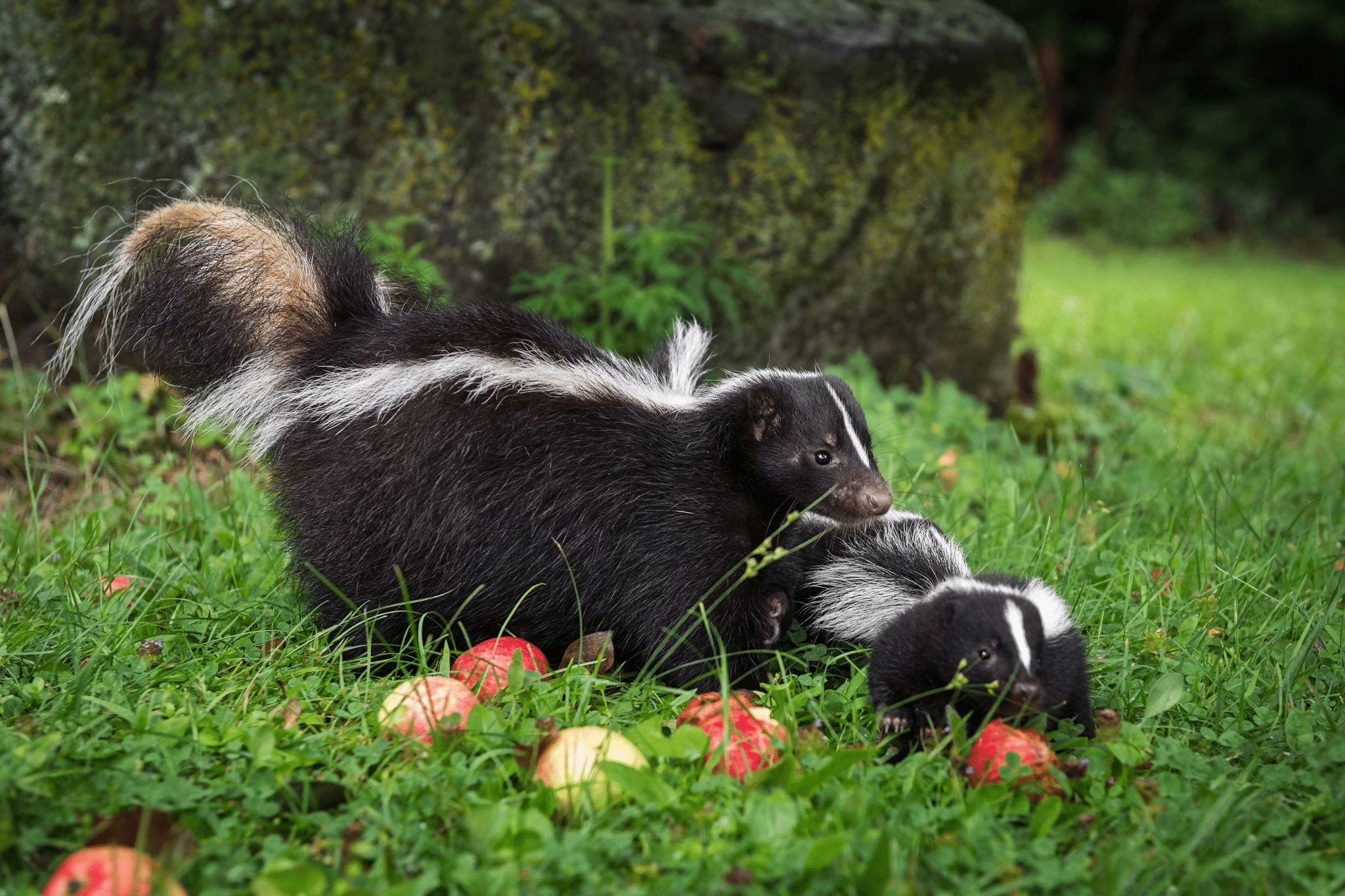What to do When Skunks Spray

What to do When Skunks Spray
Time seemed to stand still in the weeks leading up to our South Dakota pheasant hunting trip last fall. At last, the morning finally came! With trucks loaded with gear, we set out on the 6-hour drive to our pheasant mecca, anticipation building by the mile to get our feet in the tall grass and see birds flushing wild and then falling out of the sky from our deadly interlocking fire! Finally, pulling into that first field we found ourselves doing what we had been anxiously waiting to do, throwing on the orange, grabbing the shotguns and lining up across the field for five fun filled days of bird hunting in South Dakota! How could anything go wrong?
It was midday but we still had several hours of bird hunting left that afternoon. The plan was to hunt this one huge field measuring one-mile square and then drive another hour to the lodge where we were staying. We skirted along the edge of the first patch of cattails seeing the first rising rooster of our hunt until it led to a second patch. There was no way around it and in we went. If you’ve never struggled through an overgrown jungle of cattails thrust skyward by a South Dakota spring, summer and fall of flooding, then I don’t think there is any way I can describe the nightmare.
Each footstep landed on a skim of ice that would hold you for a split-second until your boot fell into the water. Each time, you hoped that the water wouldn’t be high enough to fill your muck boot. All the while, you tried in vain to push through the wall of reeded grass strong enough to hold back an ox. That was an experience that would repeat itself over and over throughout the trip. Seeing a bird that flushed was hopeless let alone shooting it. Once we pushed our way through the cattail slough we found a vast stretch of knee-high grass that looked much more favorable to hunt.
It wasn’t long before my trusty shorthair Ace locked up on a solid point in front of my friend Scott. As Scott approached I watched from afar and witnessed Scott retreat as he yelled for the dog to do the same. I knew in an instant what that meant. The dog dove in but soon retreated as well. Ace ran a straight line to me and as he went by I caught the whiff! He had gotten a full face spray from a skunk!
Ace puked and hacked while constantly rubbing his face into the ground for what seemed like the next 10 minutes and he stunk profusely. He wanted to come to me as if to say, “Help me!” but there was nothing I could do for him. Before too long he was back to his old self and we finished hunting the field. The problem was that we had found a lodge to stay at where the dog was invited to stay in the house with us. Ace is a housedog, and part of the family, so he’s used to being pretty spoiled. I knew if he spent the night in the kennel outside in a strange place that he’d be up all night barking and unrested for the grueling hunting of the next few days. Desperately I wanted him to be able to stay inside with us.
I assembled his dog crate and put him inside for the hour-long drive to our lodge. Along the way we stopped at a Mom and Pop grocery store and grabbed everything we could think of to take the skunk smell out of a dog. Shampoo, tomato juice, air-freshener, vinegar, you name it; we’d throw the kitchen sink at him. Parked alongside the store we couldn’t help but chuckle as every single person that walked by wrinkled their nose or put their coat over their nose. Some even commented that our vehicle must have hit a skunk in the road not knowing that the black shorthair in the back was doing his best impression of Pepe Le Pew!
Once we got to the lodge, the owners were so accommodating, letting me use their shop, towels and hose. While the guys began preparing supper I went to work on the dog. Under a light, poor Ace took the coldest shower of his life in the dark. I mixed a quart of 3% hydrogen peroxide with a half of a cup of baking soda and few generous squirts of Dawn dish soap into a half gallon of water and began soaking the dog down.
Working the foamy solution into his coat with my hands and a brush I’d let it stay on for five minutes before rinsing Ace with the hose. I repeated the process 3 or 4 times until the solution was almost gone, and then used shampoo generously. Ace stood shivering in the mid-thirty degree night air as his eyes showed his hatred for me. I toweled him off and then used what was left of the solution on his dog crate. It worked wonderfully and Ace was now a skunk free dog.
Day five of our trip arrived and we packed up our stuff and headed out for one last hunt before driving back to Iowa in the afternoon. We had hunted most of that last field and as we made the last turn that would take us straight back to the trucks a few hundred yards away, Ace had another nice point. I moved up in front of Ace’s nose to flush the bird obviously buried deep in the grass.
Getting nothing, I kicked at the grass until I saw Ace dive in head first in a flash. You guessed it, under my feet he came out with a skunk by the neck! As I heard the bones of that smelly weasel crunch under Ace’s powerful jaws, I quickly did my best impression of Usain Bolt and got the hell out of there! Ace dropped the skunk when he sprayed and left him alone after that! Again, Ace began the routine of throwing up and rubbing himself across the ground while I stood by using words unsuitable for print.
Knowing we had literally 15 minutes of hunting left before driving 6 hours home I was dumbfounded by our bad luck. With no way to wash the dog, we unloaded everything we could out of one pickup and into the other and put Ace in the back of my truck with his dog bed and a few treats under my tonneau cover and headed for home. Once home Ace received the same bath (only with warm water) he had received 5 days earlier. Then I power washed the bed of the pickup and threw out his dog bed.
One would think a hunting dog would learn after the first bad experience with a skunk. But they don’t. They just keep doing what hunting dogs do, even if it means getting a face full of skunk spray. I wonder if they surely realize what it is they are pointing or hunting? You would think, with their expert nose that they certainly know and would retreat but even in the face of fear, centuries of lineage indelibly force them to do what they are suppose to do…hunt the animal.
Various remedies for getting skunk smell out of a dog have been used. People have sworn by a tomato juice bath but it has limited success. Vinegar diluted in water may be one of the next best options if it’s all you have but it too doesn’t quite rid that aroma. Mixing 1 quart of 3% hydrogen peroxide, ¼ cup baking soda and 2-3 teaspoons of dishwashing soap is the best method. Use gloves when working it into the fur and please be careful around the dog’s eyes as the peroxide can sting and irritate their eyes. Repeat if needed and use a shampoo when finished for a clean smell.
Isn’t it incredible how a skunk, despite it’s shy nature and small size is one of the most feared animals in the animal kingdom. A wolf, coyote, bear or wolverine wants no part of a skunk, nor does a human. The way they flee from a skunk would make you think it is the most ferocious critter on the planet. Yet skunks try to avoid spraying unless they feel imminent danger. Skunks typically give a lot of warning before spraying. They will raise their tail and sometimes shake it vigorously to warn you before spraying while stomping their feet. They can effectively spray up to 15 feet.
Spraying is the last resort for a skunk. While they can spray up to five consecutive times, their scent glands could take up to 10 days to recharge. They would be left vulnerable to predators if they use all their scent in one encounter. The great horned owl is likely the most feared and successful predator of a skunk. Skunks have poor eyesight but good hearing and sense of smell, making them good nest robbers. They can eat both plant and animal, making grubs, earthworms, insects, rodents, lizards and eggs a regular part of their diet along with berries, roots and grasses.
In some Native American cultures crossing paths with a skunk was considered bad luck and were associated with evil sorcery. Some tribes believed that their meat was poisonous while other tribes ate their meat freely. Still other tribes believed that the skunk had medical powers and that their fragrance could ward off disease. Skunks have been trapped for centuries and with mixed popularity over time. In 2014, the average price for a skunk pelt sold at Toronto’s North American Fur Auction sold for $5.97. In 1918 during a boom in the skunk fur trade, pelts sold for $5.14 in St. Louis. That’s around $61 dollars in today’s value.
Skunk pelt harvest increased tenfold from the 1850’s till the 1880’s and then boomed to its peak in the 1930’s. Canadian pelt harvest in the 1930’s averaged 137,000 pelts per year and pelts harvested from the United States during that time swelled to 1.2 million per year. The early 1940’s saw a decline in skunk fur popularity and it continued on a downward trend into the 1960’s. Canada’s skunk pelt harvest during the decade of the Sixties went to an average annual harvest of only 600 pelts and America’s decline was 38,000 per year during the 1960’s. The market rebounded somewhat during the 1970’s and remained more steady but skunk has never saw the boom in popularity that it once did during the time period prior to WWII.
Skunk fur can make for glamorous, unmistakable fur coats. Durable and warm, the fur offers long (1-2”) guard hairs held erect by a thick underfur slightly coarser than fox. The beauty of skunk fur was highly desirable in the 1800’s and even early in the 20th century but often times lost its luster once it was worn. Early dressers both European and American struggled to deodorize the skins properly. But by WWI European demands for skunk increased leading to skunk being 2nd behind the muskrat in total value of fur being produced. Skunk farming increased because of the ease of farming. Skunks eat almost anything and were easily a domestic animal. Trappers harvested vast amounts of skunk during the Great Depression to help sustain their families when demand in Europe kept skunk pelts valuable. Skunk pelts today trade for near the same value as they did a century ago.
Trapping a skunk can be a tricky, if not, smelly situation. A few years back while my young son Dylan and I were out checking the trapline we came across the accidental catch of a skunk in one of my legholds.
I backed the pickup up to what I thought was a safe distance of 50 yards or more away. Then I walked up to the trap and shot the varmint with my .22 caliber pistol. Naturally he sprayed in his death throws and I walked back to the pickup figuring I would wait a day and then take the animal out of the trap the next day. As we got into the truck, we quickly discovered we had made a large mistake. I had left the pickup running with the vents blowing air and even though I had parked at what I thought was a safe distance away, the truck was downwind of the trap.
Yep, you guessed it; the vents grabbed that stinkified air and drew it right into the cab of the truck. For the next several weeks, you could smell the essence of skunk every time you crawled into the pickup. Each time we went somewhere, Dylan and I would climb in, look at each other and say, “Yep, still smells like skunk!”
If you are going to dispatch a skunk from a leghold trap try aiming for the lungs or heart. There is less chance of them spraying that way. Shooting them in the brain almost always unleashes the fume of odor. If you are brave enough to try and release the animal from a leghold the best way is to do it as you would with a skunk caught in a cage trap. Approach the critter slowly with a blanket or large sheet of plastic that covers your entire body. Skunks don’t see that well and as long as they don’t see the danger they won’t spray. Humming or talking in a soothing voice while approaching can be helpful.
If the animal shows any signs of defense stop or back away. As long as the skunk remains calm, slowly place the sheet over the cage or the critter. If it’s in a leghold, calmly find the chain and work your way up to the jaws of the trap until you can release the leg. Then grab the blanket and run away hoping the blanket will throw the skunk off balance long enough that he won’t be able to spray as you exit. And no.. I’ve never tried this method and hope I never will. Good luck if you try it!
by Troy Hoepker
August 2020
Check Out this article on the Fur Market –


